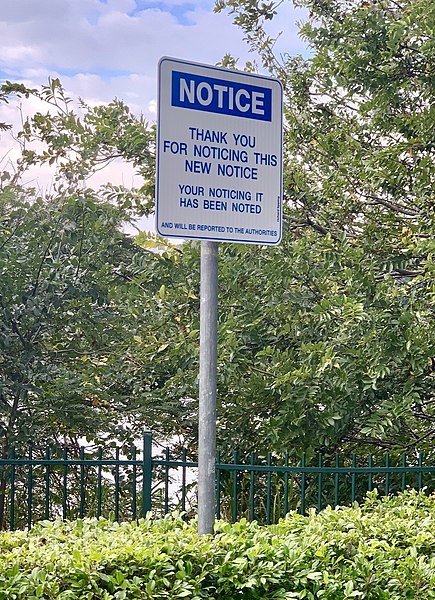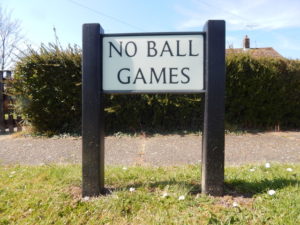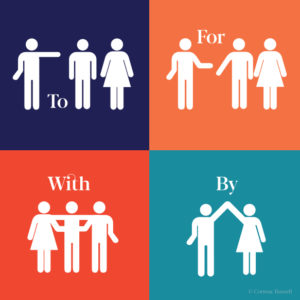
No Ball Games
It might seem over the top to have a major gripe against ‘no ball games’ signs, but hear me out. For those lucky enough to have never seen one, these signs are often found on unused green spaces in UK neighbourhoods. They are available in all shapes, sizes and colours, depending on how enthusiastic/aggressive the plea for no ball games is.
But I wonder if such signs say something about the relationship between residents and civil servants? An institution telling us where we are not permitted to kick a ball in our neighbourhood?
You won’t be surprised to know that information online about the origins of the ‘no balls game’ sign is sparse. There are suggestions that these signs were introduced originally to ensure ball play was kept away from local streets and roads. In principle, I understand the sentiment: ensure the safety of children and property. But really, let’s be truthful with ourselves. Is this what the signs were really for? These signs are meant to ensure children don’t play where they are not wanted. Perhaps this practice of dismissing children’s ball play was introduced in a time when children should be “seen and not heard”. But this needs serious review. So, let’s consider this ‘invention’ through the lens of the helpers’ crossroads.
 Likely, one of two scenarios will have played out. In the first scenario, the local authority decided in the name of safety that children shouldn’t play on specific green spaces. The local authority sent out an officer with a clipboard and tape measure to check distances between green spaces and roads. This is an example of the local authority doing TO the community. In the second scenario, a small group of residents, frustrated by noisy children, suggest “children should play, just not on my doorstep”; in turn, they lobbied their local elected official, and the sign appeared. An example of the local authority doing something FOR the community, well, at least some of it. Both of these scenarios bypass dialogue and possible conflict amongst neighbours about the safety of local children and property. And in sidestepping authentic community conversations, a range of unintended consequences result. Chief among them: we lose our green space to the might and power of the ‘no ball game’ sign and a neighbourhood asset: the green space governed by Council decree falls seemingly out of our local control, in that residents no longer feel they can control the space.
Likely, one of two scenarios will have played out. In the first scenario, the local authority decided in the name of safety that children shouldn’t play on specific green spaces. The local authority sent out an officer with a clipboard and tape measure to check distances between green spaces and roads. This is an example of the local authority doing TO the community. In the second scenario, a small group of residents, frustrated by noisy children, suggest “children should play, just not on my doorstep”; in turn, they lobbied their local elected official, and the sign appeared. An example of the local authority doing something FOR the community, well, at least some of it. Both of these scenarios bypass dialogue and possible conflict amongst neighbours about the safety of local children and property. And in sidestepping authentic community conversations, a range of unintended consequences result. Chief among them: we lose our green space to the might and power of the ‘no ball game’ sign and a neighbourhood asset: the green space governed by Council decree falls seemingly out of our local control, in that residents no longer feel they can control the space.
I must admit, learning ‘no ball games’ signs are not enforceable by law came as a surprise. There is implied ownership when it comes to whacking a huge sign in the middle of the grass; it says, “this land is owned by the institution, back off” – much like the first adventurers who traversed the Antarctic sticking flags in the ground without really knowing the local context.
When we build community in a neighbourhood, we are interested in what is local and in our control. So, when residents have ideas and plan local action together, they instinctively and routinely start with what they have and what they can use. Do you think the patch of grass in the neighbourhood with the sign right in the middle is their first port of call? I doubt it. There is not a feeling of ownership. Paradoxically, at the same time as erecting these signs, local authorities and allies are also developing strategies to engage with communities and support them to become more active in their neighbourhood. Is this an own goal? Excuse the pun.
So, where do you feel ownership, where do you feel you can make a change or have an effect on where you live? Beyond the ‘no balls games’ signs are many other interventions and practices which discourage ownership, stifling people from getting into association with one another or taking action together to make a change.
Here’s a few examples of where you most likely do not feel that sense of ownership:
- Wherever signs are telling you and yours what not to do.
- Local authority community centres that charge for room rental.
- Community meetings with a panel of experts sitting at the front with rows of chairs facing them.
All is not lost. Many savvy local authorities have already taken down their no ball games signs, including Aberdeen and Haringey, London – an action that’s worth celebrating. But, of course, there will be a knock-on effect: Local relationships between children, young people and families need to be renegotiated when balls go flying, yet this sounds like a healthy trade-off in that it provides an opportunity for communities to get to know one another again and agree how best to live together.
The next blog in this 3 -part series will explore how residents have grown and nurtured a deeper sense of ownership in their neighbourhood during the Covid-19 pandemic.
Shaun Burnett
Images:
Title Image – Wikimedia
“No Ball Games” image – Geograph

Joshua Hamilton
Thank you for writing and sharing this, 🙂 I first heard of the To – For – With – By thing through Cormac Russell, and it’s stuck with me a long while!